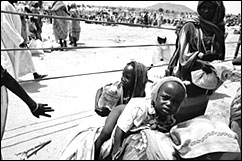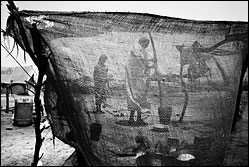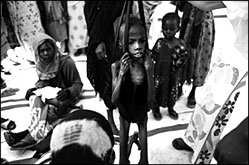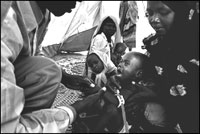For several weeks, Dr. Kai Braker was the medical coordinator for the two camps in Forchana and Breidjing. He speaks about the after-effects of displacement and the wounds that will not heal.
Doctors Without Borders/Médecins Sans Frontières (MSF) has been providing relief for the refugees in Chad for over a year now and is giving medical assistance in two hospitals and four refugee camps with a total population of some 85,000 people. For several weeks, Dr. Kai Braker
was the medical coordinator for the two camps in Forchana and Breidjing. He speaks about the after-effects of displacement and the wounds that will not heal.
It is unlikely that the Sudanese refugees will be able to return to Darfur in the foreseeable future. What sort of conditions are the people currently living in in Chad?

Photo © /MSF |
While they may be safe from attack in Chad, for many of the refugees, the living conditions in Chad one year on since they fled are still unbearable. Take the camp in Breidjing, for example: it is the largest of the camps along the Sudanese border and, with more than 43,000 refugees there, it is more than overcrowded. A third of the refugees are not registered, and those who do not have official refugee status were unable to find a place in the tents set up by the UN's refugee agency. They are living in simple makeshift shelters made using branches and plastic. Furthermore, they are not receiving sufficient food rations, resulting in malnutrition, especially amongst the children. But even when there is enough food to go round, the children can very quickly become malnourished as a result of diseases such as tuberculosis. In Breidjing alone, around 400 children are being treated by MSF with special nourishment.
Why aren't all the refugees registered?
According to UNHCR, the UN's refugee agency, Breidjing camp is only designed for a maximum of 30,000 people. But newcomers are generally unwilling to be sent to other camps as they wish to stay with the rest of their village community or family.A second camp has now been set up near to Breidjing, where several thousand refugees can be relocated. We hope that this will help alleviate the situation in terms of food and drinking water supplies in both camps.
One of the greatest risks during the rainy season was that infectious diseases such as cholera could break out. Now that the rainy season has passed, can the all-clear be sounded?

Photo © /MSF |
Fortunately, there were no outbreaks of cholera in any of the camps during the rainy season, in spite of the particularly bad hygiene levels at that time. Our efforts to install more latrines and improve drinking water supplies certainly helped in this respect. We are, however, now very concerned that there are cases of Hepatitis E in Breidjing camp. It shows just how bad the level of hygiene remains in the camp, as the pathogen for this acute liver inflammation is often passed on via contaminated drinking water. In the case of pregnant women, this disease can often be fatal. There is no effective medication for Hepatitis E, so we are only able to treat the symptoms. We are also scaling up prevention efforts by deploying more hygiene and health educators.

Photo © /MSF |
What are the main medical problems?
Diarrhea is still one of the diseases we treat most often. With the difficult living conditions in the camp, a large loss of fluids can prove to be fatal, especially for children. This problem can only be effectively solved if all the refugees have access to clean drinking water.
We are now also seeing more and more cases of malaria in our clinics – in Breidjing camp alone, we see around 160 cases every week. Not surprisingly, the majority of cases crop up in this region from October onwards, because the number of anopheles mosquitoes, the carrier of the malaria parasite, is much higher after the rainy season. The number of infected refugees has remained relatively low, however, because we sprayed the tents the refugees are living in with insecticides a number of weeks ago.

Photo © /MSF |
Measles also pose a serious threat in a camp such as Breidjing. When the disease reaches epidemic proportions, it can be fatal for up to ten per cent of all the children who catch it. We have so far managed to prevent the outbreak of an epidemic by vaccinating almost all children under the age of 15 in Breidjing – that amounts to more than 17,000 vaccinations.
Is violence a problem within or outside the camps?
The number of attacks on refugees has declined since they were transferred away from the Sudanese border into camps further inland. There has also been the odd instance of the local Chadians attacking refugees outside of the camps. But that aside, our teams in Chad are not confronted with problems arising from direct violence.
What is more of a problem is that we are invariably faced with the after-effects of violence before and during the refugees' flight. On the one hand, we treat lots of old wounds and fractures, and on the other hand, we have to treat the psychological repercussions of the violence experienced in Darfur.
Let's not forget that most of the refugees have either been mistreated themselves or were witness to extreme violence. In many cases, friends, family or neighbors were murdered before their very eyes. Consequently, many of the refugees are traumatized and suffer from panic attacks, anxiety, sleep disorders, and depression.
The refugee crisis is also taking its toll on the local Chadian population, as they have had to cope with an enormous influx of people into a region in which resources are already very sparse. Does MSF see itself as responsible for them too?
We are well aware of the fact that refugees are often the focus of international attention and relief, and that they are therefore sometimes better cared for than the locals. This is why our health centers are easily accessible both to the refugees and to the local population. And both sides take advantage of what we have to offer – approximately one in ten patients comes from Chad.
The situation in the refugee camps in Chad is highly dependent on developments across the border in Sudan. How do you envisage things developing in the next few months?
At the moment, we aren't expecting a steep rise in the number of Sudanese refugees in Chad. If, however, the situation in the large refugee camps across the border in Sudan deteriorates in terms of safety and aid supplies, we may well see another major influx.




